Royal Oak (Dunedin, Otago) Multi-cache
Royal Oak (Dunedin, Otago)
-
Difficulty:
-

-
Terrain:
-

Size:  (small)
(small)
Please note Use of geocaching.com services is subject to the terms and conditions
in our disclaimer.
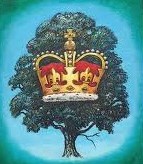 To complete this patriotic multi you will need to visit four sites in both the original and the present Dunedin Botanic Gardens. Waypoints One and Two are only accessible during the daytime, since the Lower Gardens are closed at night. The final is placed with permission amongst attractive plantings in the Botanic Garden... You may have to be a little circumspect to avoid tour groups and Knox/Salmond students, as well as other garden vistors.
To complete this patriotic multi you will need to visit four sites in both the original and the present Dunedin Botanic Gardens. Waypoints One and Two are only accessible during the daytime, since the Lower Gardens are closed at night. The final is placed with permission amongst attractive plantings in the Botanic Garden... You may have to be a little circumspect to avoid tour groups and Knox/Salmond students, as well as other garden vistors.
The "start point" is at Waypoint One, the Royal Oak in the Lower Botanic Garden. Visit the waypoints in any order and answer the questions at each waypoint. A bit of arithmetic will give you the numbers for the final.
You will find the cache, a clear 1 litre screwtop, at South 45 5X.YAB East 170 3C.WDZ.
NOTE: You do NOT need to step in any flower beds to reach the final cache.
Please use this explicit hide clue: Follow the sealed path, base of second tree under bark.
Waypoint One: The present site of the 1863 Royal Oak.
The plaque at the base of the Royal Oak has 8 lines of writing on it.
How many words in the fourth line of the plaque?
Answer = V
Waypoint Two: A much younger Royal Oak, planted on Arbour Day 1982 to commemorate the 1981 marriage of Charles & Diana.
There is a plaque in the garden at the base of the oak, partly hidden by bark chips.
How many words in the first two lines of the plaque?
Answer = W
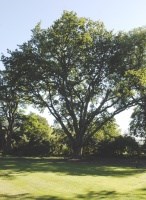 Waypoint Three: A massive deodar cedar by the St David St footbridge. Was this planted as early as 1868 when this was still the Botanic Gardens? In the early 1870s when James Gebbie had a plant nursery in Leith St? Or in 1879 when the University was built here?
Waypoint Three: A massive deodar cedar by the St David St footbridge. Was this planted as early as 1868 when this was still the Botanic Gardens? In the early 1870s when James Gebbie had a plant nursery in Leith St? Or in 1879 when the University was built here?
There is a seat underneath the conifer.
How many wooden slats make up the seat?
Answer= XY
Waypoint Four: The approximate 1863 planting site of the Royal Oak "Alexandra".
Look up to see a bas-relief of human figures on the first floor of the Burns building. (Exterior of building.)
How many panels make up the bas-relief?
Answer = Z
Checksum (all the numbers added together): V + W + X + Y + Z = 30
Arithmetic:
A = V - Z
B = V + X
C = Y - W - X
D= W + X
The final is at: South 45 5X.YAB East 170 3C.WDZ







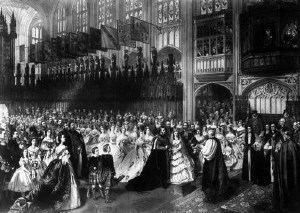 150 years ago, on 10 March 1863, Queen Victoria’s eldest son Prince Albert married Princess Alexandra of Denmark. The news reached the 15-year-old settlement of Dunedin on 22 May with the March mails from Europe, carried on the P&O steamship "Northam". The Otago Witness published full details of the ceremony and a literary tribute from the pen of Poet Laureate Alfred Tennyson.
150 years ago, on 10 March 1863, Queen Victoria’s eldest son Prince Albert married Princess Alexandra of Denmark. The news reached the 15-year-old settlement of Dunedin on 22 May with the March mails from Europe, carried on the P&O steamship "Northam". The Otago Witness published full details of the ceremony and a literary tribute from the pen of Poet Laureate Alfred Tennyson.
Planning began to celebrate the royal marriage. The Provincial Superintendant announced a public holiday on Tuesday 30 June. A public meeting appointed a Royal Marriage Celebration Committee, with numerous sub-committees to arrange the roasting of a whole ox, the erection of triumphal arches, the feasting of schoolchildren and the poor etc. The Otago Provincial Council voted £500 towards the festivities, NOT to be spent on iluminations or fireworks because of the risk of fires. The Superintendant John Hyde-Harris donated two English oak saplings from his residence on the corner of Albany and Leith Sts, the Grange.
Luckily for midwinter, Tuesday 30 June 1863 dawned fine, and a great procession with a crowd of spectators falling in behind it wended its way up Princes St and George St to the Botanical Gardens Reserve.
The two oldest gardeners in the Province, members of the [Horticultural] Society, were the bearers of the sapling oaks, which future generations will, it is hoped, look upon as gigantic trees, living memorials of the events of the day. Mr David Bower, late of Andersons Bay, carried one, and Mr John Anderson of Caversham, the other.
![1863: Prince Albert [later Edward VII] (1841–1910) m Princess Alexandra of Denmark (1844-1925)](http://img.geocaching.com/cache/log/large/267ac481-0bb2-4a9e-a8fd-04d65d3b3493.jpg)
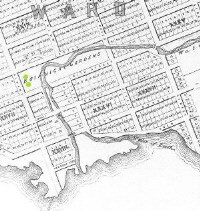 The Botanic Gardens were the two blocks bounded by Castle, Leith, St David and Albany Streets, with the Water of Leith flowing through it. The two oaks were planted on the Albany Street frontage:
The Botanic Gardens were the two blocks bounded by Castle, Leith, St David and Albany Streets, with the Water of Leith flowing through it. The two oaks were planted on the Albany Street frontage:
The scene was a most striking one. The background was formed by a hill thickly clothed with scrub, and looking delightfully green and fresh; the slope is gentle, and the bush extends well down to the level ground and a great sweep of that ground was occupied by spectators, the centre being rich in colors and in other attractions, owing to the presence of the smartly clothed children and a considerable number of ladies. Two slight mounds had been raised with holes at the top, for the trees; the newly-made ground being covered with sprays of ![1893: Prince George [later George V] (1865-1936) m Princess Mary of Teck (1867-1953)](http://img.geocaching.com/cache/log/large/0857e142-4863-441a-9667-5109b587d3d9.jpg) the larger ferns.
the larger ferns.
The Provincial Superintendent, John Hyde Harris, gave a speech:
 … I am sure that every one here will heartily join in the hope, that when the young trees which we are about to plant in commemoration of this glad event, shall have attained to maturity and in due time shall have passed away, that when the last branch of the last survivor of them shall have fallen to the ground and become incorporated with its native soil that then, and for ages afterwards, the descendants of Albert Edward, Prince of Wales, and Alexandra of Denmark may sit upon the throne, may wear the Crown, and may sway the sceptre of England over a loving people. (Loud cheers)…
… I am sure that every one here will heartily join in the hope, that when the young trees which we are about to plant in commemoration of this glad event, shall have attained to maturity and in due time shall have passed away, that when the last branch of the last survivor of them shall have fallen to the ground and become incorporated with its native soil that then, and for ages afterwards, the descendants of Albert Edward, Prince of Wales, and Alexandra of Denmark may sit upon the throne, may wear the Crown, and may sway the sceptre of England over a loving people. (Loud cheers)…
![1923: Prince Albert [later George VI] (1895 -1952) m Lady Elizabeth Bowes-Lyon (1900 – 2002)](http://img.geocaching.com/cache/log/large/1663db00-0e83-4259-89d3-6e777b799a41.jpg) One of the young oaks was now placed by its bearer, in the westerly hole; and a spade, gaily decorated with ribbons, having been handed, to his Honor, he threw some soil into the hole, so as to fix it. Proceeding to the other mound, the ceremony was repeated; and then “Three cheers for the Royal Oaks" were given, and the band played the National Anthem.
One of the young oaks was now placed by its bearer, in the westerly hole; and a spade, gaily decorated with ribbons, having been handed, to his Honor, he threw some soil into the hole, so as to fix it. Proceeding to the other mound, the ceremony was repeated; and then “Three cheers for the Royal Oaks" were given, and the band played the National Anthem.
His Honor said: I have this day planted two oak trees. That first planted I name after Alexandra, Princess of Wales; the other, I name after Albert Edward Prince of Wales. (Cheers.) ... On behalf of you all, those trees have been named; and I trust that they will in all time be known and respected as “The Royal Oaks". (Loud cheers) The Rifle Volunteers fired a feu de joie with very good effect; and three cheers were given.
The celebrations received enthusiastic and detailed coverage in the Otago Witness.![1947: Princess Elizabeth [later Elizabeth II] (1926 - ) m Prince Philip of Greece (1921- )](http://img.geocaching.com/cache/log/large/eefb50fd-2f07-4130-9036-bba96e847b2f.jpg)
A year later, a 25 Nov 1864 ODT article reported both oaks were “growing vigorously” and appeared “likely long to flourish”.
Around each of the memorial oaks, there is formed a circular bed, over 40 ft in diameter, and these beds are planted 'riband-fashion’ with rings of Spergoeia palifera (put in as an experiment, but which at home is now a frequent and very beautiful substitute for grass, on lawns and terraces, and for edgings), scarlet geranium, Lineum grandiflora (one of the flax tribe), and Nemophyllae insignis which bears a profusion of pretty blue flowers.
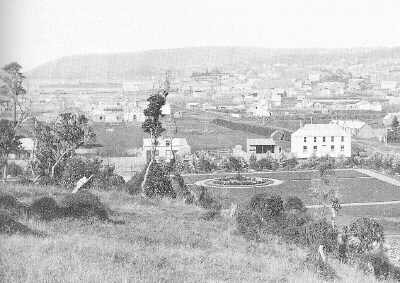 This c. 1866 photo shows the circular flower bed surrounding the Royal Oak “Alexandra”- I think she survived the 1868 floods and was transferred to the present Botanic Garden. The site would now be in the middle of the Burns building.
This c. 1866 photo shows the circular flower bed surrounding the Royal Oak “Alexandra”- I think she survived the 1868 floods and was transferred to the present Botanic Garden. The site would now be in the middle of the Burns building.
The photo was taken from Tanna Hill where the Home Science School now stands, looking over the Water of Leith towards the corner of Castle and Albany Streets. Plantings of gum trees, and native pines and cedars, border the Gardens. The other oak "Albert Edward" is hidden by the hill on the left of the photo.
 On 1-4 February 1868 a Killer Storm swept the country, causing widespread flooding. (NIWA info) Three bridges over the Leith and an entire acre of the Botanic Garden plantings were washed away, including one of the Royal Oaks.
On 1-4 February 1868 a Killer Storm swept the country, causing widespread flooding. (NIWA info) Three bridges over the Leith and an entire acre of the Botanic Garden plantings were washed away, including one of the Royal Oaks.
Following the floods the existing Garden site was recommended for subdivision and sale, while the Gardens were re-established on a section of the Town Belt at Opoho. A number of plants, including the remaining Royal Oak, were successfully transferred to the new site. This had been used as a campsite for diggers on their way to the goldfields until 1864, when it was occupied by the Otago Acclimatisation Society. The original Gardens site continued to be used for recreation, with part leased out as a nursery, until it was taken by statute in 1875 for the University of Otago campus.

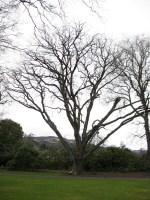 Today the Royal Oak stands beside the children’s playground, 12 m tall with a 5.6 m circumference. In 1980 steel cables were installed to support its branches, replaced by nylon cables when the canopy was thinned in 2010.
Today the Royal Oak stands beside the children’s playground, 12 m tall with a 5.6 m circumference. In 1980 steel cables were installed to support its branches, replaced by nylon cables when the canopy was thinned in 2010.
Since the English Oak lives about 250 years this oak is halfway through its lifespan. Its role in the garden will eventually be taken by another Royal Oak planted nearby in 1982 to commemorate the 1981 marriage of the then Prince and Princess of Wales.
And some things never change...we continue to be as fascinated by the most recent bud on the House of Saxe-Coburg-Gotha/Windsor family tree as those loyal Dunedinites 150 years ago.
Additional Hints
(Decrypt)
Lbh qb ABG arrq gb fgrc va nal sybjre orqf gb ernpu gur svany pnpur.
Sbyybj gur frnyrq cngu, onfr bs frpbaq gerr haqre onex.